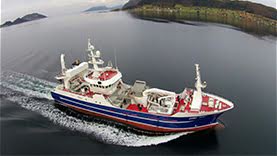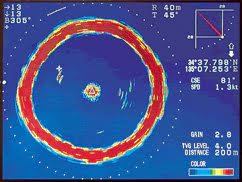Mullglen install Perle Fiber Media Converters to remove EMI from Sonar Data Transmission
5 years of unreliable data transmission on fishing trawlers finally solved by installing a fiber network for transmission of sonar fish finder data.
Modern fishing vessels are fully equipped with marine electronics such as radar systems, fish finders and navigational instruments to locate large shoals of fish. A key piece of equipment is a sonar fish finder, which finds underwater objects using sound waves. Sonars transmit ultrasonic waves into the water below and receive the returning echoes from the seabed. To locate fish schools, the sonar shows a radar-like image of the water surrounding of the ship. Furuno, a Japanese manufacturer, sells these devices for more than £250,000 to trawlers around the world who rely on them to locate their catch.
Ronan Murrin is a Marine Engineer at Mullglen Limited who works aboard the Pacelli fishing trawler based out of Ireland.

The Sonar head, located at the very front of the boat is lowered into the water and sends out a pulse which is received back into the transducer, The data is then sent over a 64m long cat7 shielded pair cable to the bridge where it is received by a computer and displayed on a visual screen for the Skipper and Captain. The Skipper and Captain interpret the data to make key navigational decisions.
Within days of a new Furuno fish-finding sonar being installed on the Pacelli, the skipper, with over 40 years of experience, knew that it was not functioning correctly.
Murrin comments, The Skipper knows these waters. He knows where the rocks are down there and that the sonar was not picking them up. The sonar was clearly unreliable and we could never trust it.
Furuno spent a lot of time and resources trying to find a solution to the reliability issues. Both the transducer and processor units were replaced. The cabling on the boat was upgraded from cat5 to cat7. And, an engineer from Japan spent 4 weeks on the boat - all to no avail.

After 5 years of back and forth, Mullglen was no closer to a solution. With a broad range of experience as an electrician and instrument engineer, Murrin took a step back.
He explains, First I decided to install a UPS (Uninterruptible Power Supply) which would provide the sonar equipment with 240v at all times. With all of the generators, motors and refrigeration equipment on board, power surges and blackouts are quite common. Then, recalling a previous training course I had done in fiber optics, I researched this and started chatting with an engineer at Perle. The reliability aspect of fiber networking, and the fact that fiber is not affected by electrical interference, made a lot of sense to me. The Perle engineer detailed how the different types of data could be streamed using Media Converters and, from there, I was 99% confident that this was be the solution we were looking for.
Murrin installed a pair of Fast Ethernet Media Converters on board the Pacelli. The first was connected to the sonar transducer at the front of the boat. The data would be transmitted over fiber to the other Media Converter connected to the display computer in the bridge.

Murrin describes the outcome, Normally when we would go to the fishing grounds, the sonar was left off, as it could only operate for a couple of hours before the data got all jumbled. After the fiber installation we could turned it on while still in the harbour. The Skipper knows the seabed there like the back of his hand. He wanted to compare the data from the sonar to that in his mind. It worked perfectly for 2 hours so he turned it off until we got to the fishing grounds. Then he turned it on and left it on continuously for 4 days straight. It worked perfectly.
EMI (Electromagnetic interference) often occurs in coaxial cables, even shielded ones. The paths that cabling can take on a boat are severely limited, and multiple cables often have to run close to each other. This increases the chances of EMI. Fiber Optics are immune to EMI since signals are transmitted as light instead of current. They can carry signals through places where EMI would normally block transmission.
Murrin’s closing comments were, The sonar manufacturer spent a lot of time and resources trying to rectify the problem. As it turned out, for very little effort and money, we solved it with a couple of Perle Media Converters.
Mullglen Limited are an Irish Fishing Fleet company incorporated in 1992.